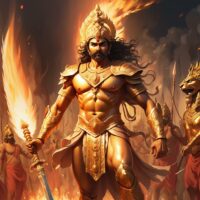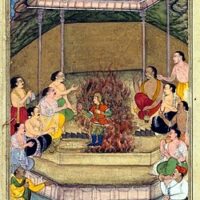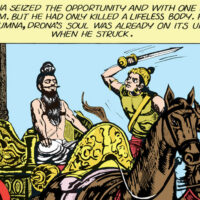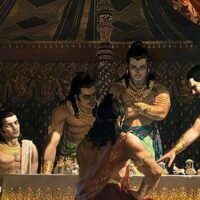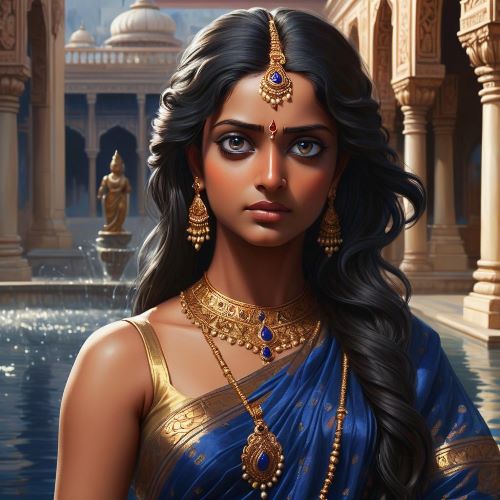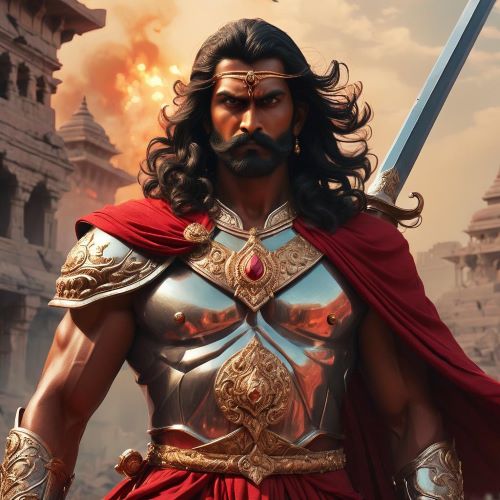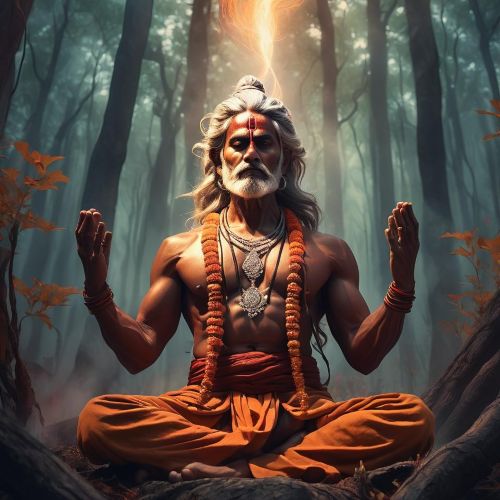Dhrishtadyumna : The Flame Born
Listen
At a glance
| Description | |
|---|---|
| Origin | Indian Mythology |
| Classification | Mortals |
| Family Members | Draupada (Father), Prishati (Mother), Draupadi, Shikhandi (Siblings) |
| Region | India |
| Associated With | Warfare, Leadership, Royalty |
Dhrishtadyumna
Introduction
Dhrishtadyumna is a remarkable character in the Mahabharata, remembered for his fiery birth, unshakable courage, and pivotal role as the commander of the Pandava army in the Kurukshetra War. He was not a warrior of ordinary origin but one brought forth through divine design, destined to alter the course of the greatest battle in Indian mythology. His life is woven with themes of fate, loyalty, and the burden of prophecy, making him one of the most fascinating warriors in epic literature. Above all, Dhrishtadyumna was prophesied to end the life of Dronacharya, the guru of both Kauravas and Pandavas, and his very existence revolved around this purpose.
Physical Traits
Dhrishtadyumna’s birth itself reflected his celestial qualities. Unlike mortals, he emerged fully grown from the flames of a yajna, clad in natural armor that gleamed like fire itself. His presence was striking—his body radiant, his bearing majestic, and his expression fierce with the determination of destiny. Ancient descriptions liken him to a mighty elephant in its prime, strong and unyielding, with a face that reflected both nobility and fire-born energy.
His weaponry was not granted later in life but appeared with him at birth, signifying his role as a divine warrior. In his hands were a sword and a bow, embodying his readiness for war. His aura of strength was matched by a discipline in speech and self-control, attributes that underscored his image as a warrior molded by both fire and dharma.
Family
Dhrishtadyumna was born into the royal family of Panchala. His father, King Drupada, created him through a sacrificial ritual fueled by vengeance against Drona, who had humiliated him. His mother, Prishati, added maternal lineage to his divine creation, but his true identity was tied to the fire altar more than any womb.
Among his siblings, Draupadi remains the most celebrated—born from the same fire, she would later become the wife of the five Pandava brothers. Another key figure in the family was Shikhandi, the reincarnation of Amba, who was destined to play a decisive role in Bhishma’s downfall. His brothers—Kshatradharma, Kshatranjay, Satyajit, and others—stood by him in the war, but none carried the prophetic weight that he bore. This family lineage was inseparable from the Pandavas, tying Dhrishtadyumna’s destiny firmly to theirs.
Other names
The many names of Dhrishtadyumna highlight his lineage, origin, and purpose. He is often called Draupada, simply meaning the son of Drupada. Other epithets such as Droṇahantā emphasized his destiny as the slayer of Drona, while titles like Pāñcāla and Pāñcālaputra identified him as the pride of the Panchala kingdom.
In different recensions of the Mahabharata, he is also addressed as Parshata, Dronaripu, and Sarvasenapati, each underscoring either his familial ties or his martial responsibilities. These names were not ornamental; they reinforced the prophecy surrounding him and constantly reminded both allies and enemies of his divine mission.
Powers and Abilities
Dhrishtadyumna’s abilities were a blend of divine power and human training. Though born for war, he was ironically trained in weaponry by none other than Dronacharya himself. This gave him not just skills in archery and swordsmanship but also an intimate knowledge of his enemy’s strategies. His leadership qualities earned him the title of commander-in-chief of the Pandava army, a role he held from the early days of the war until its brutal conclusion.
One of his greatest strengths was strategic warfare. He devised key battle formations and coordinated with other heroes like Arjuna, Bhima, and Shikhandi to challenge mighty warriors on the Kaurava side. His resilience and command inspired his troops and helped the Pandavas endure the long and exhausting conflict.
The prophecy tied to him came true on the fifteenth day of the Kurukshetra War when he fulfilled his destiny by beheading Drona, bringing about a major turning point. Yet, his own end was grim—killed mercilessly by Ashwatthama during a night raid after the war, his death symbolized the cruel cycle of vengeance that even destiny could not escape.
Modern Day Influence
In today’s cultural memory, Dhrishtadyumna continues to stand as a symbol of destiny and karmic justice. His fire-born origin and prophetic mission have made him a subject of fascination in retellings of the Mahabharata across literature, theater, and film. Writers and playwrights often explore his duality—being both a product of vengeance and a commander bound by dharma.
Artistic depictions, including temple murals and paintings, often show him alongside Draupadi, highlighting their shared divine birth. In modern cinema and television adaptations of the Mahabharata, Dhrishtadyumna’s character is portrayed as both a fierce warrior and a man carrying the heavy burden of fate.
His symbolic legacy also extends into discussions of leadership. As commander-in-chief, he embodies responsibility, discipline, and the execution of difficult duties, even when tied to personal enmity. Contemporary scholars use his story to reflect on the moral challenges of leadership, where fulfilling destiny may come at the cost of compassion.
Even in digital culture, he finds recognition—featured in articles, blogs, and mythology platforms that reinterpret his tale for a new generation. His story, alongside that of Draupadi, serves as a reminder that destiny, dharma, and divine intervention continue to shape human understanding of justice and responsibility.
Related Images
Source
Ganguli, K. M. (Trans.). (1883–1896). The Mahabharata of Krishna-Dwaipayana Vyasa. Calcutta: P.C. Roy.
https://www.sacred-texts.com/hin/maha/index.htm
Wikipedia contributors. (2025, August 20). Dhrishtadyumna. In Wikipedia, The Free Encyclopedia.
https://en.wikipedia.org/wiki/Dhrishtadyumna
VyasaOnline. (n.d.). Dhrishtadyumna – Mahabharata Encyclopedia. Retrieved August 20, 2025, from
https://www.vyasaonline.com/encyclopedia/dhrishtadyumna/
Tapas Guru. (n.d.). The Birth of Dhrishtadyumna: A Tale of Divine Intervention and Destiny. Retrieved August 20, 2025, from
https://tapas.guru/stories/the-birth-of-dhrishtadyumna-a-tale-of-divine-intervention-and-destiny
Frequently Asked Questions
What is lorem Ipsum?
I am text block. Click edit button to change this text. Lorem ipsum dolor sit amet, consectetur adipiscing elit. Ut elit tellus, luctus nec ullamcorper mattis, pulvinar dapibus leo.
What is lorem Ipsum?
I am text block. Click edit button to change this text. Lorem ipsum dolor sit amet, consectetur adipiscing elit. Ut elit tellus, luctus nec ullamcorper mattis, pulvinar dapibus leo.
What is lorem Ipsum?
I am text block. Click edit button to change this text. Lorem ipsum dolor sit amet, consectetur adipiscing elit. Ut elit tellus, luctus nec ullamcorper mattis, pulvinar dapibus leo.
What is lorem Ipsum?
I am text block. Click edit button to change this text. Lorem ipsum dolor sit amet, consectetur adipiscing elit. Ut elit tellus, luctus nec ullamcorper mattis, pulvinar dapibus leo.
What is lorem Ipsum?
I am text block. Click edit button to change this text. Lorem ipsum dolor sit amet, consectetur adipiscing elit. Ut elit tellus, luctus nec ullamcorper mattis, pulvinar dapibus leo.


